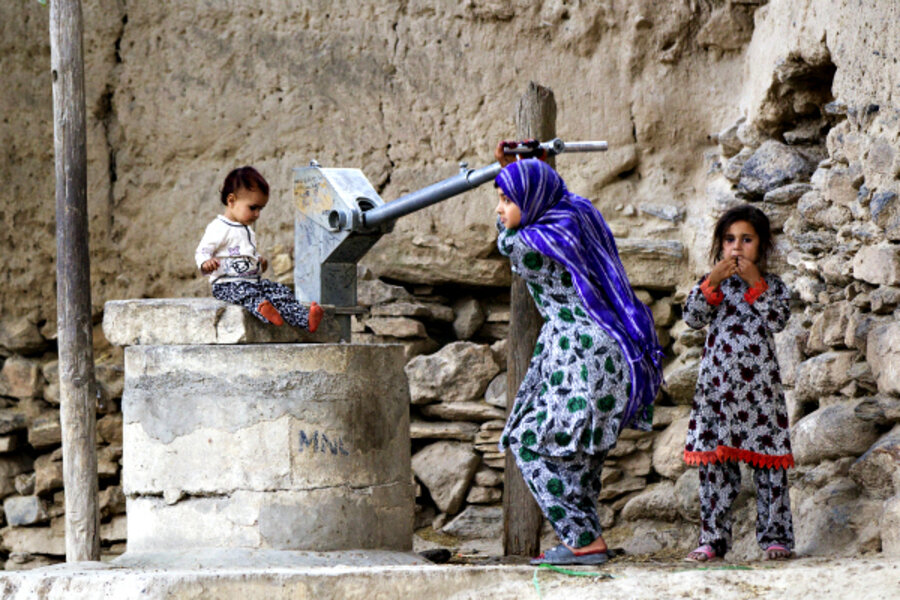Mobile technology boosts access to clean water for the poor
Loading...
| LONDON
Information technology is a powerful tool for experts working to provide secure access to water for personal use, food production, and business in developing nations.
Giving poor people proper access to safe water and sanitation would save 2.5 million people a year from dying from diarrhea and other diseases spread by a lack of hygiene, according to the charity WaterAid.
The widespread availability of mobile phones has enabled the development of low-cost solutions aimed at improving water security and reducing poverty.
Three quarters of the world's 7 billion people have access to a mobile phone, according to a World Bank report. There are 6 billion mobile subscriptions worldwide, of which almost 5 billion are in developing countries.
This is where mobile networks come in – they have led to the development of communication services that aim to increase the transparency and reliability of water delivery. For example, mobile technology has allowed service providers to monitor water supply to prevent theft and leakages, while offering more effective repairs and billing.
But these innovative efforts still face huge political and logistical challenges, complicated by the risks linked to climate change, experts say.
Here are five mobile strategies that are already helping people get better access to water and sanitation:
Supply mapping
Timely data on the state of water infrastructure is key to implementing a secure water supply. Akvo FLOW (Field Level Operations Watch) is a mobile application that uses Android-operated devices, the internet, and map-reporting tools in Google Maps and Google Earth to collect, analyze, and report data for monitoring water supplies.
The system, which has been used in 17 countries in Africa, Asia, Central America, and South America since 2010, was developed by two nonprofit organizations: Water For People, which helps communities in developing countries access clean drinking water; and Akvo, which creates web and mobile software to improve the delivery of humanitarian aid.
In 2011, the Liberian government, assisted by the World Bank, used Akvo FLOW to map 10,000 water points in Liberia.
Smart-card tap system
Lifelink, developed by Denmark-based Grundfos AS, uses submersible borehole pumps powered by solar or wind power to deliver water to an elevated storage tank.
Gravity forces the water to flow into a tap unit in a small building, which also serves as a payment facility. Customers buy water credits that are stored on a "smart card," using mobile-phone banking. They insert the smart card into a slot at the tap unit to purchase water.
A percentage of the money goes towards service and maintenance. Lifelink staff can monitor water pressure, temperature, and the amount of water tapped from anywhere in the world via the internet.
The company, which provides the service in urban and rural communities, says it has implemented drinking-water supply systems for 100,000 people in Kenya and is expanding into other African countries and Asia.
Water management by SMS
A mobile-to-web platform designed to regulate water management is improving water delivery in West Africa.
The mWater service – used by 240 small public-private piped-water schemes in Senegal, Mali, Benin, and Niger – allows water-service operators to share information with national authorities and financial institutions via mobile phone.
Text messages provide data about water-production levels, account balances, and service disruptions. mWater generates real-time reports and also archives data to provide water-scheme managers with monthly reports, which can be emailed or downloaded.
Today, more than 25 percent of rural and small-town populations in western and central Africa are served by small piped-water schemes, a proportion that is expected to rise to 80 percent by 2015, according to the Manobi Development Foundation.
Smart hand pumps
Experts estimate that a third of handpumps supplying water to some of the world's poorest people are broken at any given time, according to Rob Hope, a researcher at Britain’s University of Oxford Mobile/Water for Development (MW4D) program.
Hope is part of a team developing a mobile system that coordinates access to, payment for, and upkeep of hand pumps, which are often installed and then left for the local community to manage with varying success.
The "smart hand pumps" automatically transmit water use and performance data over the mobile network, sending a text message to alert engineers of a breakdown.
Data provides water output estimates that show fluctuations in daily to seasonal demand levels. The mobile application is being tested in 70 villages in Kenya's drought-prone Kyuso district, as part of a year-long pilot project funded by Britain's Department for International Development (DFID).
Hand-pump service centers
More than half of India’s village hand pumps are not working and remain out of use for more than 30 days due to a shortage of mechanics, according to WaterAid.
In response, the charity has set up hand pump service centers, known locally as Public Panchayat Participatory (PPP) centers, operated by locally trained mechanics in two districts of Uttar Pradesh and Bihar states.
The condition of village hand pumps is monitored by the centers and repairs coordinated by mobile phone.
Between January 2011 and March 2012, the centers oversaw the repair of more than 4,500 hand pumps serving almost 338,000 people, according to WaterAid.
Only 6 percent of the repairs took longer than two days to complete, and this was usually down to remote location, the need for major work, or a lack of spare parts, the charity says.
• This article originally appeared at AlertNet, a humanitarian news site operated by the Thomson Reuters Foundation.
• Sign up to receive a weekly selection of practical and inspiring Change Agent articles by clicking here.





